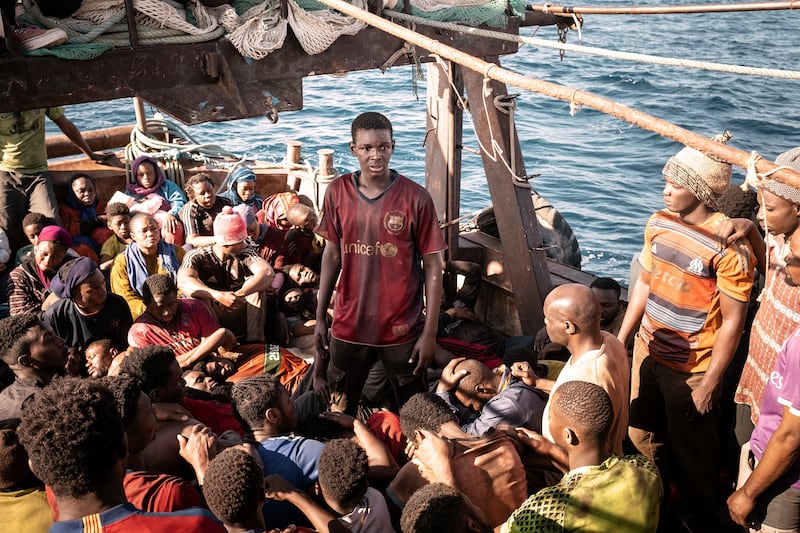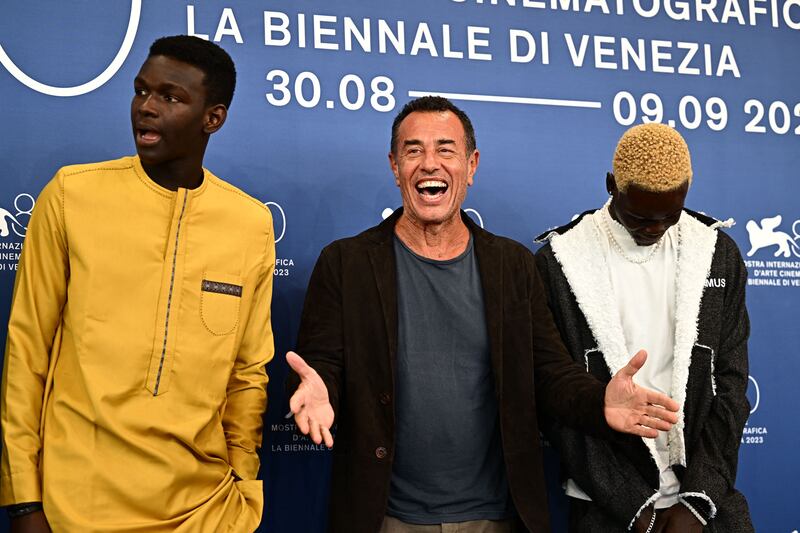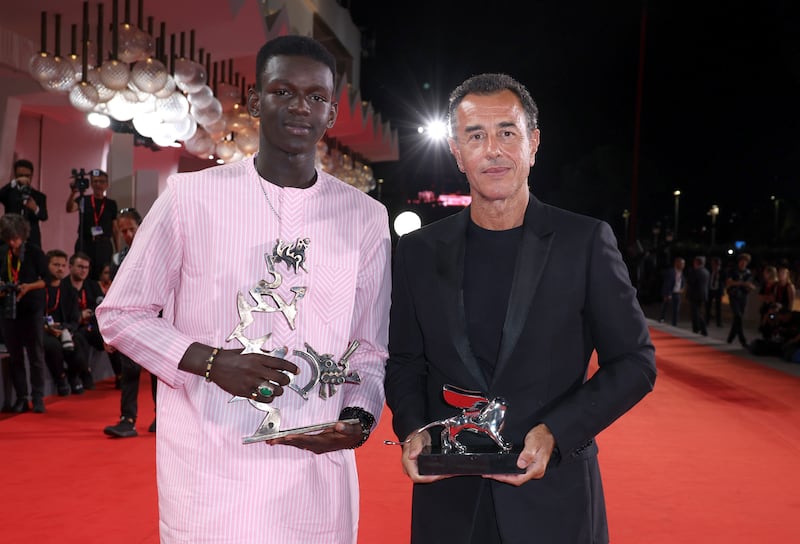Seydou Sarr, a Senegalese teenager, had no interest when his mother and sister – who are both actors – suggested he attend a casting call for a movie by a big-name European director.
The 16-year-old, who still hopes to become a professional footballer, skipped the audition and went to football practice. His determined sister retrieved him from the pitch, but the casting call was full when she dropped him off.
Sarr returned home, only to discover that he had lost his keys. While retracing his steps, someone at the call spotted him and decided to give him a shot.
One year later, the reluctant thespian was called onstage at the Venice Film Festival as the recipient of the Marcello Mastroianni Award for Best Young Actor. It was one of 12 awards, including the Silver Lion for Best Director for Matteo Garrone, won by Io Capitano at the festival.
The White Lotus review: Season three has its finger on the pulse to an almost excruciating degree
The fall and rise of Orla Kiely: ‘As horrible as it was, you just have to get on with it. There are things we won’t do again’
Competitive parenting in China: ‘School starts at 7.30am and I pick him up at 9.30 in the evening. We usually arrive home around 10pm. Then he studies again’
It’s a magical story that’s entirely in keeping with the events and tone of the film. This thrilling, tactile adventure chronicles the perilous immigrant trek from Senegal to Europe with Homeric flair.
“We tried to recreate this atmosphere of a fairy tale while trying to be true to the idea of what the film is about,” says the Italian director. “The film is about two young people who leave a country where their families are poor, but not so poor that they don’t have something to eat. They escape because they are young people and they are following a dream. At the beginning of the century in Italy, migrants went to the United States for work, but they didn’t know what they were going to see.
“Today, every day, there is a window on our country because of social media. On TikTok and Instagram, Africa can see our world. And we make promises to them. We show our countries in the best light. We create this dream of Europe. It’s contagious. It costs a lot of money to make the journey. Sometimes people sell their homes. Of course, when they arrive, they discover things that they haven’t seen before.”
[ Pinocchio: A gorgeous but dark and unsettling reworkingOpens in new window ]
On the eve of the film’s African premiere at the Marrakech Film Festival, a smiling Garrone gestures towards three young men seated nearby: Sarr, his costar Moustapha Fall, and Mamadou Kouassi Pli Adama. The script for Io Capitano required copious research and is closely based on stories of emigration from Africa to Europe from “collaborating writers” – Mamadou Kouassi Pli Adama, Arnaud Zohin, Amara Fofana, Brhane Tareke, and Siaka Doumbia.
We are used to seeing the boats arriving. We count the numbers – 300 or 200 arrive. But behind these numbers, there are human beings that are exactly like us
— Matteo Garrone, director, Io Capitano
“My son is 15 years old,” says Garrone, who was nominated for an Oscar for Io Capitano. “He can get on a plane with a passport and travel anywhere. Why do others have to risk their life?”
The numbers are stark. Garrone stresses that, over the last 15 years, more than 27,000 people have died making the journey depicted in Io Capitano. In November 2023, when we met, 2,000 people had already perished since the previous January.

“Every frame of the movie is connected to some real story,” says Garrone. “Someone really lived every experience on screen. I tried to tell this story as an intermediary. Every moment on the set, I had someone beside me who had actually lived through the experience of being tortured in Libya or went through the Sahara. It was very dangerous for me to make a movie about a culture that is not mine. And I was very worried.
“It took years to make sure I was not telling the film from my point of view as an Italian bourgeois. To take the issues and to make this movie. In the end, I decided to make this movie because I felt that the story was missing this point of view. It’s a sort of reverse shot. We are used to seeing the boats arriving. We count the numbers – 300 or 200 arrive. But behind these numbers, there are human beings that are exactly like us. With the same desires for a better life.”
Io Capitano follows two Senegalese teenagers, aspiring singer Seydou (Seydou Sarr) and his cousin, Mousa (Moustapha Fall), as they leave Dakar in search of fame and the means to support their families from afar. The boys, whose view of Europe is shaped by Instagram and the Champions League, are repeatedly warned about the dangers, and that “Europe is nothing like Africa”. Guided by a naive sense of adventure, they work diligently and save their fare, without telling their families.
Along the way, they encounter passport forgers, shady drivers and guides who speed them through the desert, with no regard for those who fall off the truck or get left behind. Every leg of the journey introduces a new set of predators. Border police administer laxatives to ensure no one has hidden money. Libyan mafia members take captives to a prison facility where they are tortured; their custodians use their mobile phones and their screams as a way to extort money from family members. Modern slavery is often the only way out.

There are, happily, kind strangers along the way such as Martin (Issaka Sawadogo), who helps Seydou at his lowest ebb. Seydou himself tries to assist those who fall behind during a hazardous trek through the Sahara desert. Remarkably, Garrone, assisted by his remarkable young lead Sarr, maintains a sense of exuberance and adventure during the darkest episodes.
Pope Francis is a fan: a special screening of the film took place at his Domus Sanctae Marthae residence last September with Garrone and the film’s cast in attendance. But younger audiences, particularly teenagers, have played a crucial role in the film’s box office success across Europe, especially in Italy, where the film took €400,000 on its opening weekend. Unpleasant episodes, including torture, happen off-screen.

“For me, it was very important to make a movie accessible for young people,” says Garrone. “For them, it’s an adventure movie. It’s the journey of the hero to the promised land. In Italy, it’s really incredible. There are screenings at schools and they are a big, big success. Schools booked out screenings from September to March. For me, it is very important, because there will be an audience that normally wouldn’t go to see the movie.
“When I go to meet students, I ask how many of them have already seen the movie. And of 500, you see maybe five. For the other 495, they see the movie, thinking they are going to see something boring. And then they see something that talks about them. To live. To go abroad. To follow their passions even when their parents are worried about what they do. And they go back home and they suggest the movie to the parents. And that’s another way to reach an audience that maybe doesn’t go immediately.”
Garrone, the son of theatre critic Nico Garrone and photographer Donatella Rimoldi, exploded onto the cinematic landscape in 2008 with Gomorrah, a grotty, gripping corrective to Hollywood representations of the Mafia. Adapted from Roberto Saviano’s study of Neapolitan Mafia group the Camorra, the film won the jury prize at the Cannes Film Festival. He has subsequently become one of Italy’s most imaginative chroniclers. Reality charts the Italian experience of reality TV through a star-struck fishmonger; Dogman dramatised the crimes of Pietro De Negri, better known as Er Canaro, a notorious criminal, dog coiffeur and cocaine addict; Tale of Tales saw various movie stars – Salma Hayek, Vincent Cassel, and John C Reilly – enact a collection of fairy tales by Italian poet Giambattista. And despite stiff competition from Hollywood contenders including Disney and Guillermo del Toro, Garrone’s 2019 film Pinocchio is hands down the superior version of Carlo Collodi’s novel The Adventures of Pinocchio.
Io Capitano is the filmmaker’s first project looking at Italy from the outside. It was a leap of faith for Garrone: his carefully compiled Italian script was translated into French and then back into Wolof, the most common Senegalese dialect. He relied on the sound of the actors’ voices to determine how each take went.
“Every film is a personal journey that helps you to discover a new part of yourself,” says Garrone. “But this was bigger because there are real migrants on set who are recreating their journies. I had to enter a culture that was not mine and make the movie with them. I’m not telling my story; I’m helping other people to tell their stories.”
Io Capitano is in cinemas April 5th



















